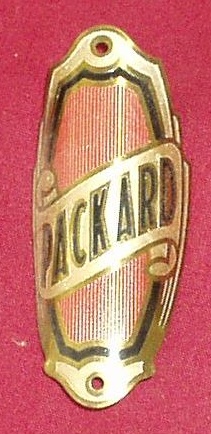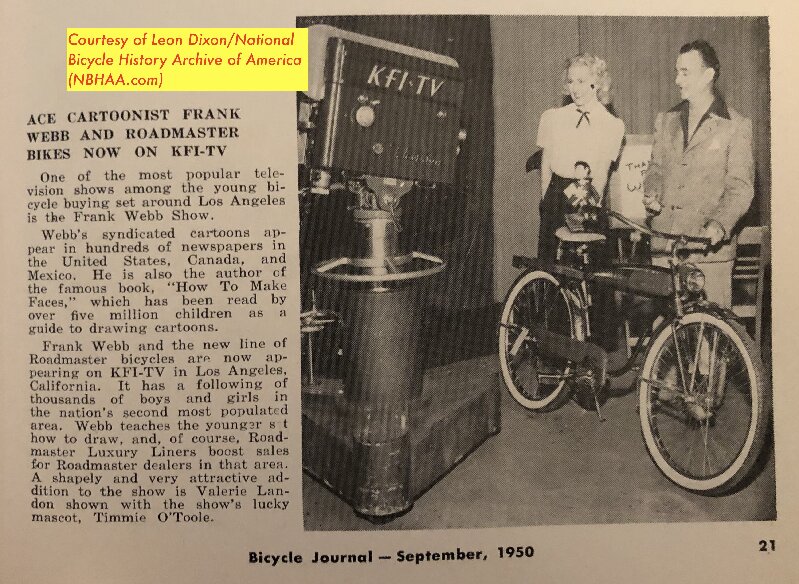Re: Packard Bikes
Posted by Leeedy On 2023/12/10 16:22:43
And now for something REALLY new! Pay close attention because THIS six-degrees of separation takes many wild twists and turns!
From the bulging National Bicycle History Archive of America (NBHAA.com), something that ties Packards, bicycles, technology, automotive styling of Brooks Stevens, bicycle design, early gas stations, early TV and the amazing Earle C. Anthony all into one! Yesss... we'll pull this alllllll together for you right here.
If you know your Packard history, you'll know that Cleveland Welding Company supplied early wheels to Packard Motor Car Company and developed demountable rim technology used on early Packard vehicles.
By the mid-1930s, Cleveland Welding Company (CWC) jumped into the bicycle business with both feet. The result was a very well made premium line of bicycles known as "Roadmaster" brand. Now, for those who think of Roadmaster as a cheaper-made brand from the 1960s-1970s, we're talking about the original 1930s to 1950s era of Roadmasters. And those were super-premium, high technology bicycles with the ultimate in craftsmanship!
Additionally, Cleveland Welding Company also made SOME of the Packard bicycles. I'm attaching an image of a CWC-built Packard bicycle headbadge, courtesy of Leon Dixon and National Bicycle History Archive of America.
Now. One of the early Los Angeles television stations was KFI-TV. It was the sister channel to KFI-AM radio– which still exists today. Who originally owned KFI? None other than the amazing Packard West Coast Distributor and genius extraordinaire, Mr. Earle C. Anthony.
Originally, KFI had what was known as "Clear Channel" status with the FCC. This meant that no other broadcaster could transmit on the same channel. Thus it was possible to listen to KFI just about anywhere one could pick up the AM signal (Mr. Anthony used to sail his yacht to Hawaii and Tahiti, listening to KFI out on the waves... He did likewise in his private train car). Of course this was long before "Clear Channel" became a brand name as it is today.
Of course, again, if you know your Packard history, Mr. Anthony's list of accomplishments and firsts is almost endless. He built what may have been the first electric car in California as a teen. He was West Coast Packard Motor Car Company Distributor with some of the world's most magnificent dealerships. Founder of one the the earliest and most successful radio channels in California. The man who brought the first commercially successful NEON SIGN to America and licensed the Claude Neon Company in the USA. Started National Supply Stations which ultimately became CHEVRON gas stations of today. And on and on.
KFI-TV did one of the first broadcasts in SoCal and featured famous Betty White to do it. KFI-TV was the progenitor of television cooking shows. KFI-TV featured a cooking show with a famous local female host in a staged kitchen– made to appear as if in a mansion. And KFI-TV had other great programming.
Famous cartoonist, Frank Webb (he did the very popular Raising Kane comic strip in national newspapers and lots of others) also appeared on KFI-TV. Mr. Webb had his own syndicated TV show called Let's Draw (... "Are you ready kids? Hurry up... hurry up ... get your paper and pen and draw!"). (You have to be a certain age to remember this stuff.)
Let's Draw was sponsored by Roadmaster Bicycles division of Cleveland Welding Company. The TV show was largely geared toward kids. Roadmaster even adopted a Disney-esque advertising mascot. An elf named "Roady Roadmaster."
Contrary what people today and the internet will lead you to believe, Roadmaster bicycles were VERY popular and sought-after between the 1930s and the end of the 1950s. And as I said, they made a number of Packard-branded bicycles.
Who designed Roadmaster and CWC-built "Packard" bicycles? Why, none other than the famous automotive designer, Brooks Stevens. Brooks, (who I knew and corresponded with for years) also did work for Studebaker and Packard.
I am attaching a very, very rare photo and clipping from the bicycle industry trade magazine, Bicycle Journal. BJ was originally published by my old friend, Bill Quinn out of Fort Worth, Texas. Yesss NBHAA has the entire hardbound archive of Bicycle Journal magazine which dates back to the 1940s.
Shown in this photo is a 1950 Roadmaster Luxury Liner which was CWC's top-of-the-line bicycle. The Luxury Liner was the direct competitor to Schwinn's "Phantom" series. The Luxury Liner featured a very advanced front suspension fork; chrome fenders, crescent handlebars, "Searchbeam" headlight; electric horn; and a special rear carrier with built-in electric tail light/brake light (yes, applying the brake actually made the tail light illuminate brighter– just like in a car! In case anyone is wondering, the tag near the right rear axle nut was to tell you about the electric brake light operation).
For those dyed-in-the-wool hardcore Cleveland Welding Company Roadmaster Luxury Liner fans, NOTE that the chain guard does NOT say "Luxury Liner" or anything at all. Contrary to what you will see on the internet or on the awful so-called "authentic reproductions" of these bicycles made in recent years.
Had enough for now? Sit back and breathe easy... there's always more to come!
Images courtesy of Leon Dixon / National Bicycle History Archive of America (NBHAA.com).
Attach file:
 PackCWBadgeCR.jpg (48.47 KB)
PackCWBadgeCR.jpg (48.47 KB)

 KFI-TVandRoadmasterBicycleNBHAAWM.jpeg (1,080.67 KB)
KFI-TVandRoadmasterBicycleNBHAAWM.jpeg (1,080.67 KB)

From the bulging National Bicycle History Archive of America (NBHAA.com), something that ties Packards, bicycles, technology, automotive styling of Brooks Stevens, bicycle design, early gas stations, early TV and the amazing Earle C. Anthony all into one! Yesss... we'll pull this alllllll together for you right here.
If you know your Packard history, you'll know that Cleveland Welding Company supplied early wheels to Packard Motor Car Company and developed demountable rim technology used on early Packard vehicles.
By the mid-1930s, Cleveland Welding Company (CWC) jumped into the bicycle business with both feet. The result was a very well made premium line of bicycles known as "Roadmaster" brand. Now, for those who think of Roadmaster as a cheaper-made brand from the 1960s-1970s, we're talking about the original 1930s to 1950s era of Roadmasters. And those were super-premium, high technology bicycles with the ultimate in craftsmanship!
Additionally, Cleveland Welding Company also made SOME of the Packard bicycles. I'm attaching an image of a CWC-built Packard bicycle headbadge, courtesy of Leon Dixon and National Bicycle History Archive of America.
Now. One of the early Los Angeles television stations was KFI-TV. It was the sister channel to KFI-AM radio– which still exists today. Who originally owned KFI? None other than the amazing Packard West Coast Distributor and genius extraordinaire, Mr. Earle C. Anthony.
Originally, KFI had what was known as "Clear Channel" status with the FCC. This meant that no other broadcaster could transmit on the same channel. Thus it was possible to listen to KFI just about anywhere one could pick up the AM signal (Mr. Anthony used to sail his yacht to Hawaii and Tahiti, listening to KFI out on the waves... He did likewise in his private train car). Of course this was long before "Clear Channel" became a brand name as it is today.
Of course, again, if you know your Packard history, Mr. Anthony's list of accomplishments and firsts is almost endless. He built what may have been the first electric car in California as a teen. He was West Coast Packard Motor Car Company Distributor with some of the world's most magnificent dealerships. Founder of one the the earliest and most successful radio channels in California. The man who brought the first commercially successful NEON SIGN to America and licensed the Claude Neon Company in the USA. Started National Supply Stations which ultimately became CHEVRON gas stations of today. And on and on.
KFI-TV did one of the first broadcasts in SoCal and featured famous Betty White to do it. KFI-TV was the progenitor of television cooking shows. KFI-TV featured a cooking show with a famous local female host in a staged kitchen– made to appear as if in a mansion. And KFI-TV had other great programming.
Famous cartoonist, Frank Webb (he did the very popular Raising Kane comic strip in national newspapers and lots of others) also appeared on KFI-TV. Mr. Webb had his own syndicated TV show called Let's Draw (... "Are you ready kids? Hurry up... hurry up ... get your paper and pen and draw!"). (You have to be a certain age to remember this stuff.)
Let's Draw was sponsored by Roadmaster Bicycles division of Cleveland Welding Company. The TV show was largely geared toward kids. Roadmaster even adopted a Disney-esque advertising mascot. An elf named "Roady Roadmaster."
Contrary what people today and the internet will lead you to believe, Roadmaster bicycles were VERY popular and sought-after between the 1930s and the end of the 1950s. And as I said, they made a number of Packard-branded bicycles.
Who designed Roadmaster and CWC-built "Packard" bicycles? Why, none other than the famous automotive designer, Brooks Stevens. Brooks, (who I knew and corresponded with for years) also did work for Studebaker and Packard.
I am attaching a very, very rare photo and clipping from the bicycle industry trade magazine, Bicycle Journal. BJ was originally published by my old friend, Bill Quinn out of Fort Worth, Texas. Yesss NBHAA has the entire hardbound archive of Bicycle Journal magazine which dates back to the 1940s.
Shown in this photo is a 1950 Roadmaster Luxury Liner which was CWC's top-of-the-line bicycle. The Luxury Liner was the direct competitor to Schwinn's "Phantom" series. The Luxury Liner featured a very advanced front suspension fork; chrome fenders, crescent handlebars, "Searchbeam" headlight; electric horn; and a special rear carrier with built-in electric tail light/brake light (yes, applying the brake actually made the tail light illuminate brighter– just like in a car! In case anyone is wondering, the tag near the right rear axle nut was to tell you about the electric brake light operation).
For those dyed-in-the-wool hardcore Cleveland Welding Company Roadmaster Luxury Liner fans, NOTE that the chain guard does NOT say "Luxury Liner" or anything at all. Contrary to what you will see on the internet or on the awful so-called "authentic reproductions" of these bicycles made in recent years.
Had enough for now? Sit back and breathe easy... there's always more to come!
Images courtesy of Leon Dixon / National Bicycle History Archive of America (NBHAA.com).
Attach file:
 PackCWBadgeCR.jpg (48.47 KB)
PackCWBadgeCR.jpg (48.47 KB)
 KFI-TVandRoadmasterBicycleNBHAAWM.jpeg (1,080.67 KB)
KFI-TVandRoadmasterBicycleNBHAAWM.jpeg (1,080.67 KB)
This Post was from: https://packardinfo.com/xoops/html/modules/newbb/viewtopic.php?post_id=265714